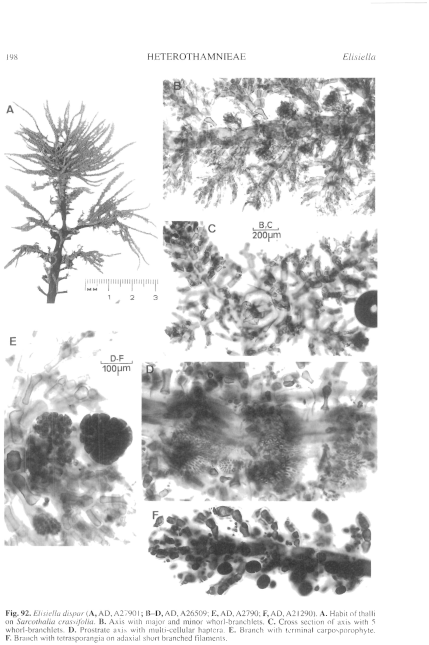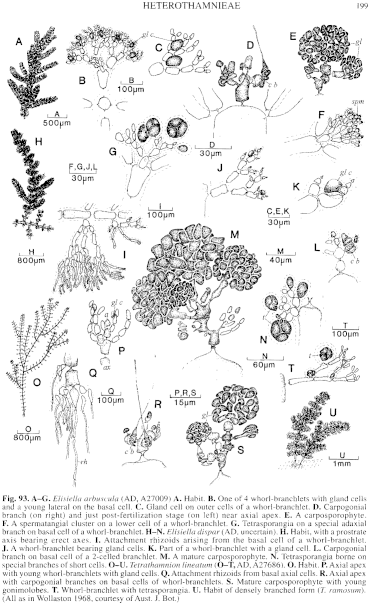|
|
|
|
|
|||||||||||
|
Electronic Flora of South Australia Species Fact Sheet
Phylum Rhodophyta – Order Ceramiales – Family Ceramiaceae – Tribe Heterothamnieae
Synonyms
Callithamnion dispar Harvey 1859b: 335; 1862: pl. 227. J. Agardh 1876: 27. Sonder 1881: 10. Tisdall 1898: 502. Wilson 1892: 186.
Antithamnion dispar (Harvey) J. Agardh 1892: 20. De Toni 1903: 1405. De Toni & Forti 1923: 54. Guiler 1952: 97. Lucas 1909: 51; 1929a: 25. Lucas & Perrin 1947: 353. Womersley 1948: 162; 1950: 178.
Perithamnion dispar (Harvey) Wollaston 1968: 373, fig. 34H–P.
Tetrathamnion dispar (Harvey) Athanasiadis 1996: 194, fig. 104.
Thallus (Figs 92A, 93H) with a prostrate base bearing free main axes 2–8 cm long, these with shorter more or less alternately distichous laterals (Fig. 92B) and further irregular laterals, some developing into long axes, each axial cell with (4–) 5 whorl-branchlets (Fig. 92B, C), closely arranged along axes. Attachment by multicellular rhizoids (Figs 92C, 93 I) with digitate ends, from prostrate filaments (Fig. 92D) 100–200 µm in diameter and L/D 1.5–2; epiphytic on various larger algae, especially on Perithalia. Structure. Apical cells 6–8 µm in diameter and L/D 1–1.2, enlarging within a few cells to axial cells 60–100 µm in diameter and L/D 1.2–1.5, and in main axes 300–500 (–600) µm in diameter and L/D 1–1.4. Each whorl of whorl-branchlets (Fig. 92C) with 3 longer ones, 220–380 µm long and two shorter ones 60–90 µm long, one of the longer ones usually forming an alternate lateral branch more or less distichously arranged and 600–800 µm long; in the lower thallus any of the whorl-branchlets may form a lateral branch, and short lateral branches bear only 4 equally spaced whorl-branchlets 200–260 µm long; whorl-branchlets are usually shorter and less branched towards the base of axes. Whorl-branchlets (Fig. 93J) consist of several successive subdichotomies, with basal cells 45–80 µm in diameter and L/D 1.5–2, tapering only over the last 2–3 cells to subterminal cells 8–12 µm in diameter and L/D 0.8–1, with the terminal cell mucronate (Fig. 93K); gland cells (Fig. 93K) prominent, borne on outer cells of whorl-branchlets, touching the bearing cell and abutting the next outer cell, more or less ovoid but adjoining walls sharply angled, 12–20 µm in diameter. Cells uninucleate; rhodoplasts discoid to elongate, becoming ribbon like in larger cells.
Reproduction: Gametophytes dioecious. Carpogonial branches (Fig. 93L) borne on basal cells of short branchlets near apices, with a small sterile cell. Carposporophytes (Figs 92E, 93M) borne near apices of lateral branches, never on the main axes, with a terminal and several lateral gonimolobes 100–180 µm across of carposporangia 16–25 µm in diameter. Spermatangia on branched clusters borne on lower cells of whorl-branchlets (Athanasiadis 1996, fig. 104F, G).
Tetrasporangia (Figs 92F, 93N) occur terminally on special short branches on basal (or second) cells of whorl-branchlets, subspherical, 40–55 µm in diameter, tetrahedrally divided.
Type from the E coast of Tasmania (Gunn); lectotype in Herb. Harvey, TCD, on Mychodea disticha, isotype in BM.
Selected specimens: Vivonne Bay, Kangaroo I., S. Aust., on Perithalia, drift (Wollaston, 30.i.1956; AD, A20386). Pennington Bay, Kangaroo I., S. Aust., epiphytic, drift (Womersley, 24.v.1945; AD, A2790). Robe, S. Aust., on Perithalia?, drift (Womersley, 18.viii.1957; AD, A21290). Nora Creina, S. Aust., on Perithalia, 13 m deep (Mitchell, 26.v.1963; AD, A26509). NW of Penguin I., Beachport, S. Aust., on Macrocvstis spines, 7 m deep (R. Lewis, 11 .xi.1973; AD, A44304). Bridgewater Bay, Vic., epiphytic, drift (Beauglehole, 17.vii.1949; AD, Al2070). Point Lonsdale, Vic., on Perithalia (Nash, 28.xi.1934; AD, A49954 - Tilden, South Pacif. Pl., Second Ser, No. 158). Peggy's Point, Bicheno, Tas., on Gigartina crassifolia, pools and fringe (Wollaston & Mitchell, 2.iii.1964; AD, A27907).
Distribution: Vivonne Bay, Kangaroo I., S. Aust., to Point Lonsdale, Vic., and E Tasmania.
References:
AGARDH, J.G. (1876). Species Genera et Ordines Algarum. Vol. 3, Part 1- Epicrisis systematic Floridearum, pp. i-vii, 1–724. (Weigel: Leipzig.)
AGARDH, J.G. (1892). Analecta Algologica. Acta Univ. lund. 28, 1–182, Plates 1–3.
ATHANASIADIS, A. (1996). Morphology and classification of the Ceramioideae (Rhodophyta) based on phylogenetic principles. Opera Botanica No. 128, pp. 1–216.
DE TONI, G.B. & FORTI, A. (1923). Alghe di Australia, Tasmania e Nouva Zelanda. Mein. R. Inst. Veneto Sci., Lett. Arti 29, 1–183, Plates 1–10.
DE TONI, G.B. (1903). Sylloge Algarum omnium hucusque Cognitarum. Vol. 4. Florideae. Sect. 3, pp. 775–1521 + 1523–1525. (Padua.)
GUILER, E.R. (1952). The marine algae of Tasmania. Checklist with localities. Pap. Proc. R. Soc. Tasmania 86, 71–106.
HARVEY, W.H. (1859b). Algae. In Hooker, J.D., The Botany of the Antarctic Voyage. III. Flora Tasmaniae. Vol. II, pp. 282–343, Plates 185–196. (Reeve: London.)
HARVEY, W.H. (1862). Phycologia Australica. Vol. 4, Plates 181–240. (Reeve: London.)
LUCAS, A.H.S. & PERRIN, F. (1947). The Seaweeds of South Australia. Part 2. The Red Seaweeds. (Govt Printer: Adelaide.)
LUCAS, A.H.S. (1909). Revised list of the Fucoideae and Florideae of Australia. Proc. Linn. Soc. N.S.W. 34, 9–60.
LUCAS, A.H.S. (1929a). The marine algae of Tasmania. Pap. Proc. R. Soc. Tasm. 1928, 6–27.
SONDER, O.W. (1881). In Mueller, F., Fragmenta Phytographiae Australiae. Supplementum ad volumen undecinum: Algae Australianae hactenus cognitae, pp. 1–42, 105–107. (Melbourne.)
TISDALL, H.T. (1898). The algae of Victoria. Rep. 7th Meet. Aust. Ass. Adv. Sci., Sydney, 1898, pp. 493–516.
WILSON, J.B. (1892). Catalogue of algae collected at or near Port Phillip Heads and Western Port. Proc. R. Soc. Vict. 4, 157–190.
WOLLASTON, E.M. (1968).Morphology and taxonomy of southern Australian genera of Crouanieae Schmitz (Ceramiaceae, Rhodophyta). Aust. J. Bot. 16, 217–417.
WOMERSLEY, H.B.S. (1948). The marine algae of Kangaroo Island. II. The Pennington Bay Region. Trans. R. Soc. S. Aust. 72, 143–166, Plates 10–15.
WOMERSLEY, H.B.S. (1950). The marine algae of Kangaroo Island. III. List of Species 1. Trans. R. Soc. S. Aust. 73, 137–197.
The Marine Benthic Flora of Southern Australia Part IIIC complete list of references.
Publication:
Womersley, H.B.S. (24 December, 1998)
The Marine Benthic Flora of Southern Australia
Rhodophyta. Part IIIC. Ceramiales – Ceramiaceae, Dasyaceae
©State Herbarium of South Australia, Government of South Australia
Illustrations in Womersley Part IIIA, 1998: FIGS 92, 93 H–N.

Figure 92 enlarge
Fig. 92. Elisiella dispar (A, AD, A27901; B–D, AD, A26509; E, AD, A2790; F, AD, A21290). A. Habit of thalli on Sarcothalia crassifolia. B. Axis with major and minor whorl-branchlets. C. Cross section of axis with 5 whorl-branchlets. D. Prostrate axis with multi-cellular haptera. E. Branch with terminal carposporophyte. F. Branch with tetrasporangia on adaxial short branched filaments.

Figure 93 enlarge
Fig. 93.A–G. Elisiella arbuscula (AD, A27009) A. Habit. B. One of 4 whorl-branchlets with gland cells and a young lateral on the basal cell. C. Gland cell on outer cells of a whorl-branchlet. D. Carpogonial branch (on right) and just post-fertilization stage (on left) near axial apex. E. A carposporophyte. F. A spermatangial cluster on a lower cell of a whorl-branchlet. G. Tetrasporangia on a special adaxial branch on basal cell of a whorl-branchlet. H–N. Elisiella dispar (AD, uncertain). H. Habit, with a prostrate axis bearing erect axes. I. Attachment rhizoids arising from the basal cell of a whorl-branchlet. J. A whorl-branchlet bearing gland cells. K. Part of a whorl-branchlet with a gland cell. L. Carpogonial branch on basal cell of a 2-celled branchlet. M. A mature carposporophyte. N. Tetrasporangia borne on special branches of short cells. O–U. Tetrathamnion lineatum (O–T, AD, A27686). O. Habit. P. Axial apex with young whorl-branchlets with gland cells. Q. Attachment rhizoids from basal axial cells. R. Axial apex with carpogonial branches on basal cells of whorl-branchlets. S. Mature carposporophyte with young gonimolobes. T. Whorl-branchlet with tetrasporangia. U. Habit of densely branched form (T. ramosum). (All as in Wollaston 1968, courtesy of Aust. J. Bot.)

|
Email Contact: State Herbarium of South Australia |

|